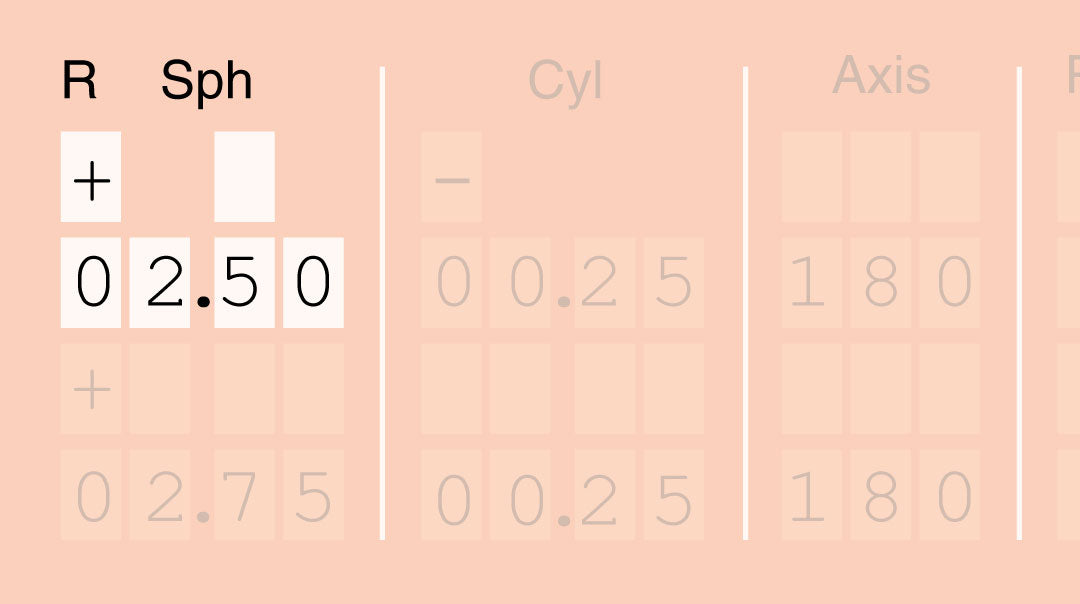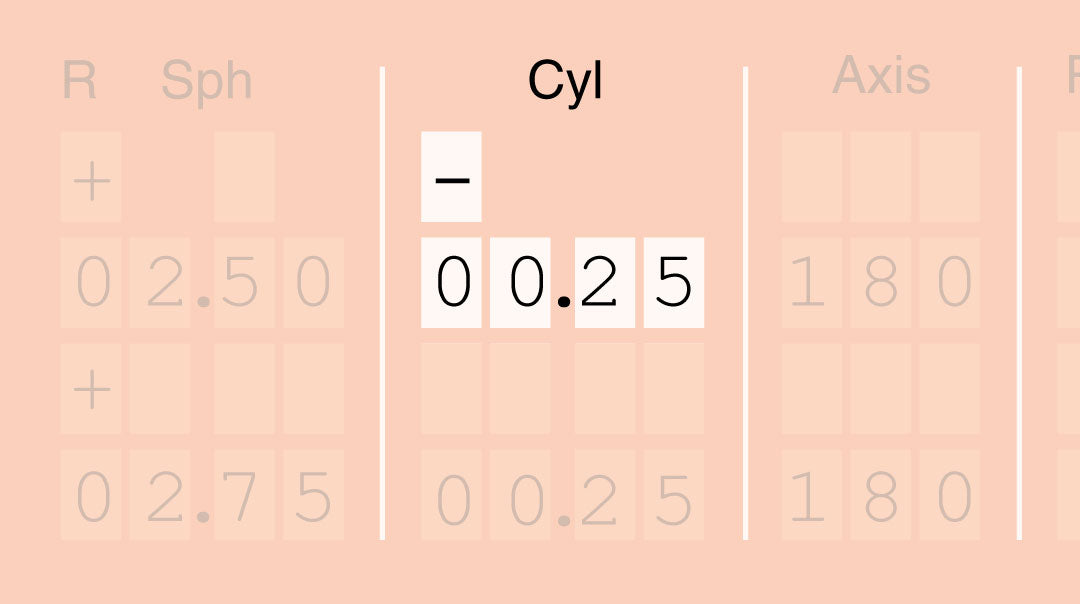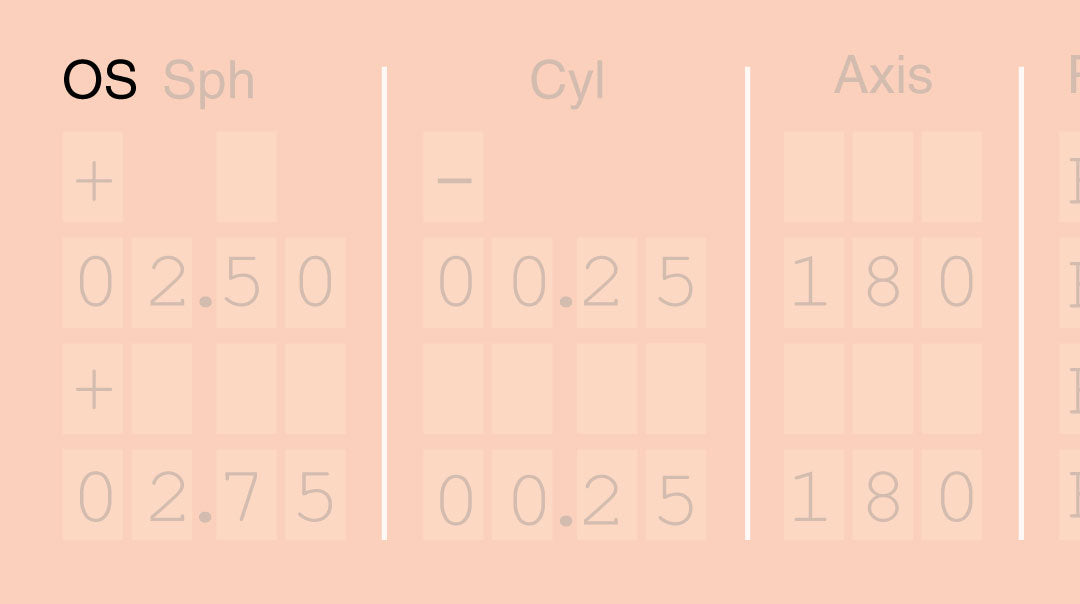Eye test results can look like a foreign language.
It’s no surprise—terms like Sph, Cyl, Axis, and Prism might seem confusing at first glance.
But these numbers and abbreviations are essential. They determine how your lenses are shaped, angled, and cut to provide your optical correction.
In this guide, I’ll walk you through each part of your prescription, making it easy to understand what those eye test results really mean.
Table of contents
What does SPH mean?
What does CYL mean?
What does Axis mean?
What does ADD mean?
What does Prism mean?
What does Plano mean?
OD meaning
OS meaning
OU meaning
Prescription enititlement

What do the numbers on eye test mean?
Your eye test results focus on two key aspects: the dioptric correction for your vision and (if required) any dioptric correction for astigmatism. These aspects are shown in separate columns labelled SPH (Sphere), CYL (Cylinder), and AXIS.
But that’s not all—your prescription might also include additional values like ADD, which indicates the need for multifocal lenses known as varifocals or progressives.
You may also notice that your right eye details are listed first. This is because prescriptions are written from the perspective of the examiner, therefore your right eye always precedes your left eye.
How do I read my eye test results?
Your prescription document will feature various sections, typically titled with abbreviations that refer to various optical corrections. Here's a quick breakdown of what each abbreviation means.
SPH = Sphere (dioptric power for near or farsightedness)
CYL = Cylinder (dioptric power for astigmatism)
AXIS = The orientation (in degrees) of your CYL power
ADD = Addition (Additional magnification required)
Prism = Dioptric correction for muscular imbalance in your eyes
Plano = Zero dioptric power required
OD = Right eye (Oculus Dexter)
OS = Left eye (Oculus Sinister)
OU = Both eyes (Oculus uterque)

Example of right eye Sphere prescription | Positive SPH | +2.50
What is SPH on eye prescription?
SPH is shorthand for sphere and refers to the dioptric power of your lenses to correct either short or long sightedness. SPH is measured in dioptres and can be written as positive (+) or negative (-) values for each of your eyes.
Positive SPH means you're hyperopic (far-sighted) when you can see objects far away clearly, but close objects are blurry.
Negative SPH means you have myopic (near-sighted) when you can see objects near to you clearly, but objects far away are blurry.
Zero SPH (0.00) means you have no refractive error. (See plano below)
The higher the SPH number, the stronger the curvature and power of your lenses. If your SPH is stronger than +/-4.00, you should consider using high index lenses as they can be very thick and protrude from the rim of your glasses frame.
If you're buying lenses online, here’s a guide on what thickness of lenses to choose based on your SPH and CYL powers.
- Thinned: SPH +/-4.00-6.75 CYL max +/- 2.00
- Super Thin: SPH +/-7.00-9.00 &/or CYL max +/- 2.00
- Ultra thin: SPH +/-7.00-9.00 &/or CYL +/-2.25-6.00
Back to top ↑

Example of right eye Cyl prescription | Minus Cyl | -0.25
What is CYL on eye prescription?
CYL is shorthand for Cylinder which denotes the dioptric power required to correct astigmatism in either of your eyes. Cylindrical power is written as a positive (+) or negative (-) value which refers to the dioptres requires to correct myopic or hyperopic astigmatism.
Astigmatism is a refractive error that occurs when the cornea (the outermost layer of the eye) has an uneven curvature, causing light rays to focus on multiple points instead of just one. This results in blurred or distorted vision at any distance.
If your CYL boxes are empty for either of your eyes, this means you have no astigmatism and therefore no requirement for any AXIS either. However, this condition is extremely common and it’s likely you’ll have slight astigmatism in at least one of your eyes.
- 0.00 to 1.00 = low astigmatism
- 1.00 to 2.00 = mild astigmatism
- 2.00 to 3.00 = high astigmatism

Example of right eye Axis prescription | 180 degrees from meridian
What is AXIS on eye prescription?
AXIS refers to the angle of orientation for your cylindrical (CYL) correction. This value is measured in degrees ranging from 1° to 180°. So you know, CYL and AXIS are inter-related, therefore if your prescription contains a CYL value, you'll always have an AXIS value too.
AXIS has nothing to do with the severity of your prescription. This is simply an angle (in degrees) which will often be seen as 20°, 90°, 120° or 170° etc.
In some instances, your optometrist may have written your CYL and AXIS freehand which can be separated by an “X”.
For example: CYL +1.50 x 60.

Example of right eye Addition on prescription | Positive (+) 2.75 dioptres in each eye
What is ADD on eye prescription?
ADD refers to any Additional magnification you may require from your lenses. These digits are measured in dioptres and will always be written as a positive (+) value. ADD is always identical in both your left and right eye.
If you require addition, this means you can use multifocal lenses such as bifocals or varifocals. These lenses feature an additional magnification portion in the lower half of your lenses, helping you focus at a close or intermediate distance.
The inclusion of ADD indicates your required correction for presbyopia. A common condition which occurs during middle-age which inhibits your close reading capability. Anything within 30cm from your eyes is considered as close-vision and is catered for in the lowest region of your lenses.
But here's the twist.
If you have an ADD value, you can have single vision lenses made for one of three 'vision zones'.
- Close-vision (within 30cm)
- Intermediate vision (arm's length)
- Distance vision (beyond arm's length)

Example of right eye Prism prescription | 0.5 Sph, Base upwards
What is PRISM in eye prescription?
PRISM denotes the dioptric power required to correct any muscular imbalance in your eyes. Prism is measured in dioptres and caters for various conditions such as strabismus (lazy eye), diplopia (double vision) or amblyopia (squint.)
If PRISM is present on your eye test results there will be two boxes per eye. Together, these related figures communicate both the dioptric power and orientation of the prism required.
In the first box, the dioptric power of your PRISM will be noted using fractional or metric figures. Depending on the preference of the optometrist, this can be indicated as ½ or 0.5, ¾ or 0.75, 1 ½ or 1.5 etc.
If written freehand, you may see a small triangle (Δ) between your prismatic power and base orientation. This is the Greek symbol for Delta which, for example, can be used to write a base inwards prism as: 0.5 Δ BI
In the second box the orientation of your PRISM will be noted in full or shorthand terms as seen listed below.
BU = Base up
BD = Base down
BI = Base in (towards the middle of your frame)
BO = Base out (towards the outside of your frame)

Example of a plano prescription | No corrective power (0.00)
What does plano mean on eye prescription?
Plano refers to your lack of Spherical dioptric power. This means you're neither nearsighted or farsighted in that particular eye. Plano derives from the Latin word plānus for “flat” informing that your lens has no corrective power. Plano may be written in several ways such as 0.00, PL, or even an infinity symbol (∞).
It's worth noting that plano prescriptions can be used in conjunction with astigmatism correction. Whilst you may not require any spherical correction, you may still need a cylindrical power and associated axis orientation.
Plano lenses can be used for a number of reasons.
- No SPH power required
- Blindness in left or right eye
- For blue light protection/gaming glasses
- Fashion or acting purposes

Latin abbreviation for left eye | Oculus sinister (OS)
What does OD, OS and OU mean on prescription?
OD, OS and OU are optical abbreviations referring to your left, right and both eyes. They derive from the Latin phrases and can be written on your prescription paper to precede optical information. Here are their translations.
- OD / Oculus dexter = Right eye
- OS / Oculus sinister = Left eye
- OU / Oculus uterque = Both eyes

Can I get a copy of my eye prescription?
By UK law, you are entitled to your eye prescription information.
Regardless of any changes or how frequently you have an eye examination, you should be provided with at least a physical copy of your results.
“Following an eye test, your ophthalmic practitioner is legally required to provide you with your optical prescription or a statement setting out that you have been referred for further tests."
However, it’s worth noting that certain optical measurements are not mandatory and may not be included on your eye test results. Most commonly? Your pupillary distance.
This is a basic measurement which can hinder you from buying glasses online, however is easily overcome by measuring it yourself using a ruler or PD ruler. Here’s one for free you can download and print. (It’s mighty accurate.)
Hopefully you found this article helpful. Please check out our other eyecare blogs. Thanks for stopping by.
